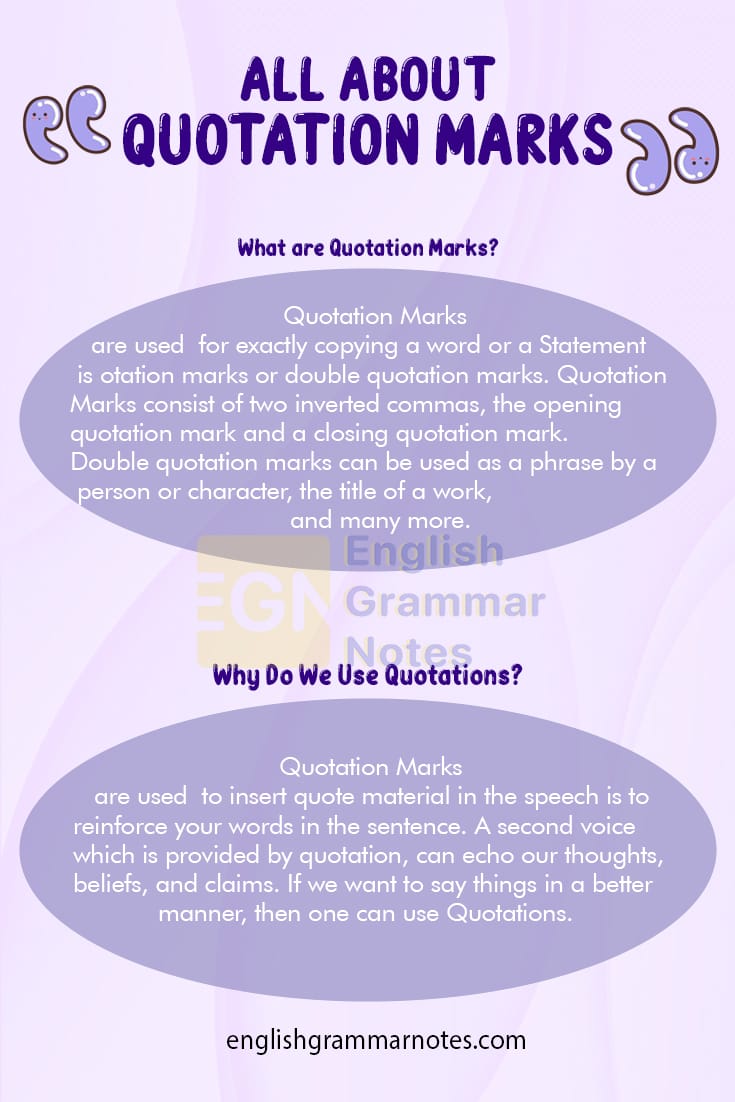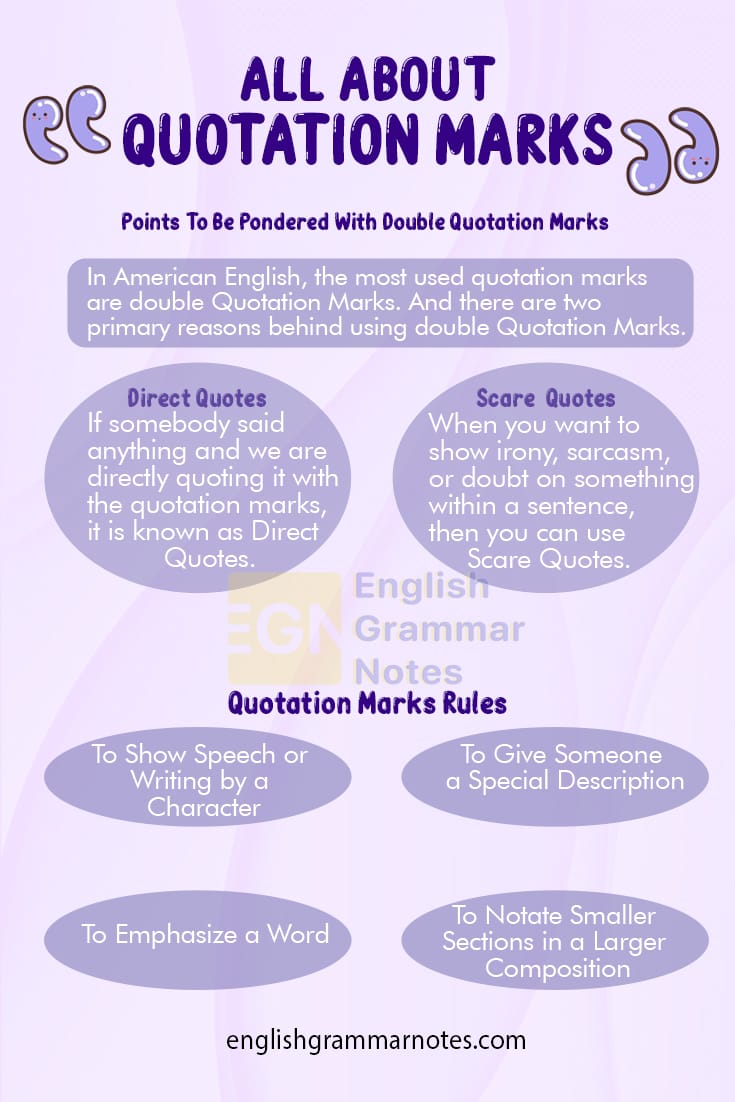Quotation Marks: Here we will be discussing quotation marks like single quotation marks and double quotation marks with their examples. Throughout the topics, we will be discussing direct quotes, Scare Quotes, To Show Speech or Writing by a Character, and many more. Let’s begin the topic with quotation marks.
- What are Quotation Marks?
- Why Do We Use Quotations?
- Points To Be Pondered With Double Quotation Marks
- Single Quotation Marks
- Quotation Marks Rules
- Single Quotation Marks within a Passage Enclosed by Double Quotation Marks
- Final Words on Quotation Marks
What are Quotation Marks?
The punctuation mark used for exactly copying a word or a Statement is Quotation marks or double quotation marks. Quotation Marks consist of two inverted commas, the opening quotation mark and a closing quotation mark. Double quotation marks can be used as a phrase by a person or character, the title of a work, and many more. British and American are the two essential rules regarding quotation Marks.
Why Do We Use Quotations?
The main reason to insert quote material in the speech is to reinforce your words in the sentence. A second voice which is provided by quotation, can echo our thoughts, beliefs, and claims. If we want to say things in a better manner, then one can use Quotations.

Points To Be Pondered With Double Quotation Marks
In American English, the most used quotation marks are double Quotation Marks. And there are two primary reasons behind using double Quotation Marks.
Direct Quotes
If somebody said anything and we are directly quoting it with the quotation marks, it is known as Direct Quotes.
For example:
- “I hate you,” she said.
- Marina said,” I will be cooking noodles today.”
- “Shifa, eat this!” Ajay shouted.
Scare Quotes
When you want to show irony, sarcasm, or doubt on something within a sentence, then you can use Scare Quotes. When we say something, but it is the opposite of what we want, or we doubt something, Scare Quotes will be helpful in these cases too. For
For example:
Glaciers are melting because of global warming. – This is a doubtful sentence, as the writer doubts that Glaciers are melting.
Anas was so “strong” it was hurtful to watch.– Here, we are showing that Anas was anything, but still, he was strong.
Love was supposed to be equal to a heaven feeling. Here, it is shown that love might be equal to heaven for others, but it was not equal to heaven feeling for the writer.
Single Quotation Marks
Single Quotation Marks are only used for two main scenarios. So keep in mind that you don’t use double quotation marks for the condition given below:
When you want to show a quote within a quote, then single quotation marks are used.
When you have to show a quote inside a headline of an article, then single quotation marks are used.
When to Use Quotation Marks
Quotation Marks Rules
To Show Speech or Writing by a Character
If you want to indicate the speech or writing by another person in your writing, then quotation marks can be used for this purpose. We will be giving examples on the above topic, so one has a clear idea about it.
For example:
- Anas shouted. “it’s none of my business.”
- “I don’t want to talk,” said Mr. Bilakhiya.
Quotation marks are often used for the longest quotation. Quotations are also used in block quotes and can also be used for an entire paragraph. There are the following cases in which one can’t use Quotation marks, and they are as follows: Instead, special formatting, font, or indenting as this all are used in emphasizing the quotes.
To Give Someone a Special Description
For a person or item, in the form of a nickname or general identifier for an item with no name and indicating the unique or unusual descriptors, one can use Quotation marks.
Examples:
Her name is Shifa “Impossible “Rubina.
In the first example, the nickname “Impossible” is a unique descriptor for Shifa Rubina. She is not known by that nickname to everyone, and it is an uncommon identifier for shifa.
To Emphasize a Word
When you want to indicate a word with an unusual expression, a common word with an alternate description, and in other ways where the word is different from standard usage, we can use Quotation marks for these all above sentences.
Example: She had a “video chat “with her best friend yesterday.
For showing euphemism in the above example, the word “video chat” is used. She didn’t want to video chat with her best friend; because she found out that her best friend is two-faced.
To Notate Smaller Sections in a Larger Composition
We can use Quotation marks for Poems and also for short stories.
Examples:
- The first part of The Harry Potter is titled “Harry Potter and Sorcerer’s stone.”
- “Attention” is an album song by Charlie Puth.
- The final episode of The Harry Potter in which Voldemort is killed is named “Harry Potter and the deathly hallows part 2.”

Single Quotation Marks within a Passage Enclosed by Double Quotation Marks
Many times it is necessary to have a quote within another quoted passage. When the characters are requoting themselves or other characters, the quote within another quoted passage can be seen easily. This can happen for only those four reasons which are mentioned above. When such instances occur, you can use double quotation marks to mark a primary quote, quote within a quote, or use single quotation marks for secondary quotes.
Examples:
“I completely meant it when I said ‘I hate you.” (Re-quote)
Final Words on Quotation Marks
This is all we can talk about Quotation Marks: What Are They and When Do We Use Them? If you are interested in grammar and punctuation marks, we hope this article will help you and find it informative. If you have found this article helpful, interesting and informative, then share this article with your friends too. We have tried to discuss and cover the topic in detail.